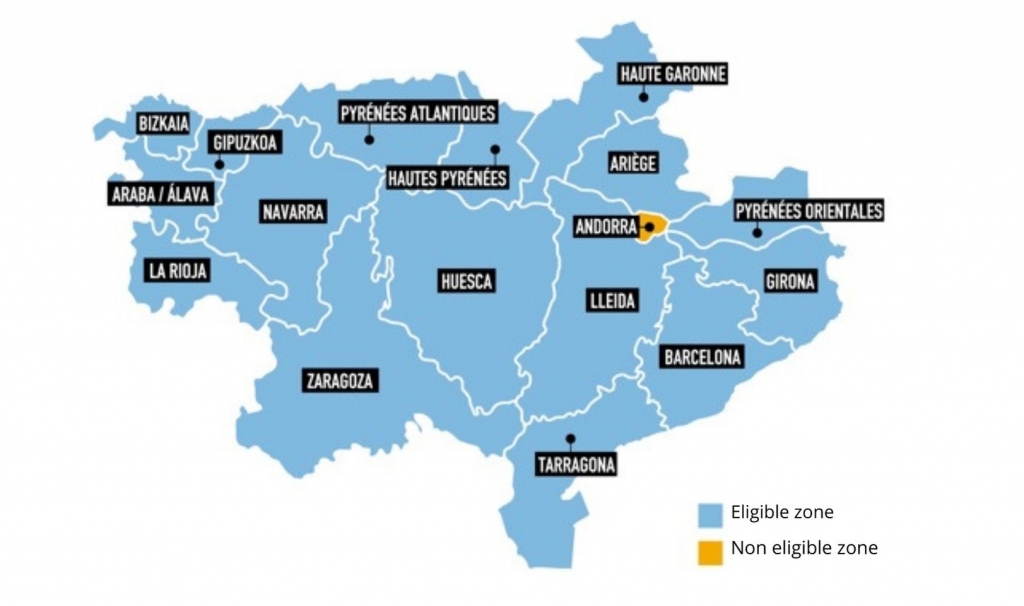What is POCTEFA ?
The Interreg Program V-A Spain-France-Andorra (POCTEFA) is a European program for cross-border cooperation in the Spain-France-Andorra frontier. The program’s aim is to give financial support to European projects thanks to the European Regional Development Fund (ERDF). This support allows to reinforce the economic and social integration of the area and to promote sustainable development.
The program improves the life of the population living in the cross-border area. One of the stakes is to enhance local, regional or interregional strategies to a cross-border scale by fostering exchanges and common knowledge. The financed projects are acting on both sides of the frontier and are preserving the territory resources.
The program’s managing authority is the Working Community of the Pyrenees (CTP in Spanish and French) and includes 7 members: two French regions (Nouvelle-Aquitaine and Occitanie), four Spanish communities (Aragon, Navarra, Catalunya, Euskadi) and Andorra. The surface of the territory is 115.583 km2 with more than 15 million inhabitants.
The cooperation zone unites these areas :
- Spain: Bizkaia, Gipuzkoa, Araba / Álava, Navarra, La Rioja, Huesca, Zaragoza, Lleida, Girona, Barcelona et Tarragona
- France : Pyrénées-Atlantiques, Ariège, Haute-Garonne, Hautes-Pyrénées, Pyrénées-Orientales
- Andorra : the entire territory
All these areas are eligible-except for Andorra which is not a UE member- to receive ERDF.
173 projects have been programmed for the 2014-2020 period for a global budget of 173 million Euros. A programmed project can receive a funding of 65% of its total budget. This European financial support offers new opportunities for cooperation between institutions and agents from both sides of the Pyrenees.
The program is organized in calls for projects. During a call, the actors of the territory interested in developing cross-border projects that fall into the cooperation zone must submit their candidatures to the Program. Once presented, the Program managing authority chooses the projects that suit the requirements of the territory and the proposal criteria. These projects will then be programmed and would be eligible for co-financing from the ERDF.
The 5 Axis
The program is also organized in 5 Axis:

Axis 1: Broadening and improving cross-border capacities in research, development and innovation and enhancing the competitiveness of SME
This first axis corresponds to the Investment Priorities (IP) of the European Union:
>IP 1b to reinforce cooperation in the territory by promoting business investment in R&I, and to help develop innovative technologies linked to natural resources.
This IP reaches the Specific Objective SO 1(Strengthen cooperation between the different actors of the territory on both sides of the border in R & D & I) and SO 2 (Encourage the development of innovative technologies in the field of natural resources thanks to cooperation)
>IP 3b to favor the implementation of new business models for SMEs and their internationalization.
This IP reaches the SO 3 (To favor the joint development actions of the companies of the transboundary territory in the international scope).

Axis 2: Promoting climate change adaptation, risk prevention and management
The second axis corresponds to the Investments Priorities of the European Union:
>IP 5a that improves the adaptation to climate change, with ecosystem-based approaches.
This IP reaches the SO 4 (Improve the adaptation of territories to climate change).
>IP 5b that promotes investment to address specific risks, to ensure disaster resilience and develop disaster management systems.
This IP reaches the SO 5 (Improve the capacity of anticipation and response of the actors of the territory to the specific risks and to the management of natural catastrophes).

Axis 3: Conserving and protecting the environment and promoting resource efficiency
The third axis corresponds to the Investments Priorities of the European Union:
>IP 6c wants to conserve, protect and promote natural and cultural heritage.
This IP reaches the SO 6 (Enhance the natural and cultural heritage through joint approaches to sustainable development).
>IP 6d protects and restores biodiversity and soil and promotes ecosystem services and green infrastructures.
This IP reaches the SO 7 (Protect and improve the quality of transboundary ecosystems).

Axis 4: Promoting sustainable transport
The fourth axis corresponds to the Investments Priorities of the European Union:
>IP 7c to develop and improve environmentally-friendly (including low-noise) and low-carbon transport systems to promote sustainable regional and local mobility.
This IP reaches the SO 8 (Improve the supply of sustainable cross-border transport to support the movement and cross-border mobility of people and goods).

Axis 5: Promoting sustainable employment, social inclusion and labour mobility
The fifth axis corresponds to the Investments Priorities of the European Union:
>IP 8e that promotes sustainable and quality employment and supports labour mobility.
This IP reaches the SO 9 (Promote the endogenous potential, the development of the training systems and the competences of the people of the transboundary territory in order to improve access to employment).
>IP 9a that invests in health and social infrastructure which contributes to national, regional and local development, reducing inequalities in terms of health status, promoting social inclusion through improved access to social, cultural and recreational services.
This IP reaches the SO 10 (Improve access to services).
The program is currently working on the 2021-2027 period.


